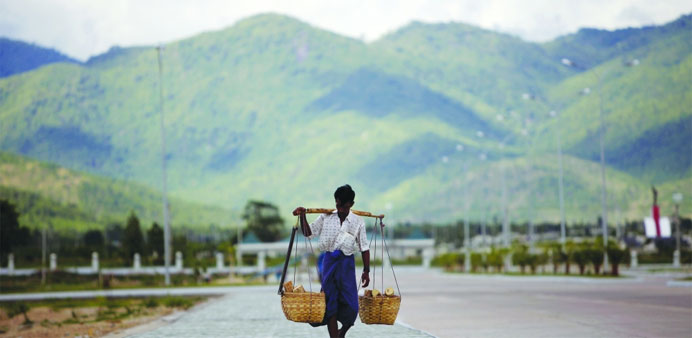A man carries baskets filled with logs of wood past a construction site in Naypyidaw, Myanmar. The formerly most isolated Southeast Asian country, is witnessing an unprecedented boom with an astounding surge in international tourist arrivals.
By Arno Maierbrugger/Gulf Times Correspondent/Bangkok
Tourism in Myanmar, the formerly most isolated Southeast Asian country, is witnessing an unprecedented boom with an astounding surge in international tourist arrivals, up 93% since 2012 as compared to 2013. Tourism receipts were also skyrocketing and reached $926mn in 2013 against some $400mn in 2012, according to official government figures. The country is confident that visitor numbers will more than double, from 2mn in 2012 when the reclusive nation started to make it generally easier for tourists to visit and move around, to 5mn by 2015, said Myanmar’s President Thein Sein at a speech he gave earlier in April to tourism organisations in Yangon.
This is the upside of the development. The downside is that the country is in dire need of tourism and hospitality infrastructure and depends to a great extent on foreign investors to build enough hotels, resorts and roads, as well as develop formerly almost inaccessible areas that hold enormous potential for tourism such as the southern island in the Andaman Sea and the northern mountainous regions which boast Southeast Asia’s highest mountains but are practically out of reach for tourists due to non-existing roads or airports.
Thein Sein mentioned that the Myanmar Tourism Master Plan 2013 to 2020 has identified 38 projects that require $486mn of funding to bring tourist attractions up to an international standard, and this is only the beginning. Tourist arrivals are expected to reach over 7mn in 2020, and revenue from the tourism industry should reach $10.18bn in the same year, which indeed indicates explosive growth.
This is a window of opportunity for investors and tourism developers from the Gulf, as companies feel definitely enticed by the new open access to the country, with the two most remarkable developments being Qatar’s Ooredoo investing billions of dollars in Myanmar’s telecom infrastructure and Qatar Airways having opened direct flights from Doha to Yangon in October 2012.
Another Gulf company that has already set up shop in Myanmar is UAE industrial group Al Marwan, which wants to build road infrastructure and hotels and also set up trade and marine services in the country.
In the tourism segment, basically everything is needed, most of all, hotels and related leisure facilities, together with appropriate infrastructure. Yangon, for example, is suffering from a strong undersupply in hotel rooms which has led to extreme price distortions in the hospitality market.
Meanwhile, Novotel, Best Western, Hilton, Shangri-La and other chains have already entered Myanmar or have signed agreements with local partners. What will also be needed are resort developers for high-end tourism project on Myanmar’s southern islands, which have been almost completely off the beaten tourist track up to now - apart from a few diving sites accessible by boat and special permit -, but are part of Myanmar’s tourism master plan with which is obviously wants to compete with Thailand.
And the comparison is not far-fetched: Experts see Myanmar similar to Thailand 30 years ago with regards to tourism development, and having the same if not a better potential. And it could close up fast to its wealthier neighbour.

